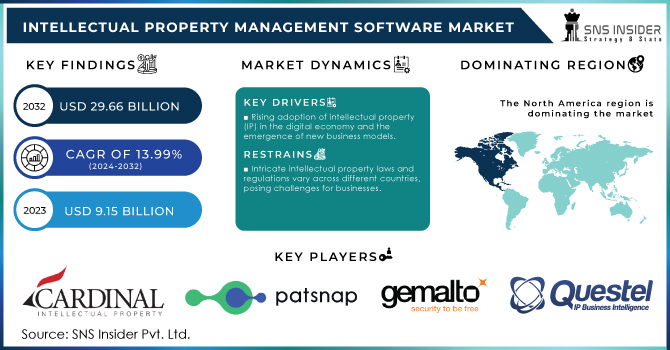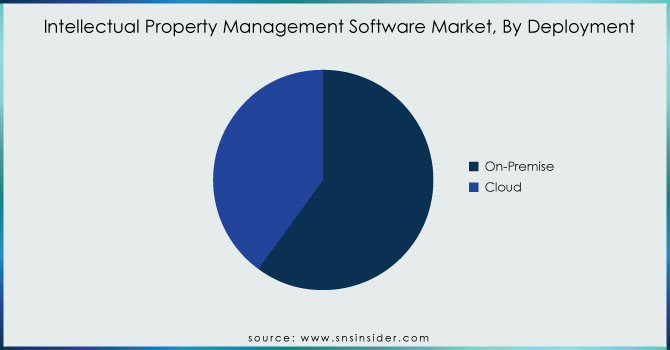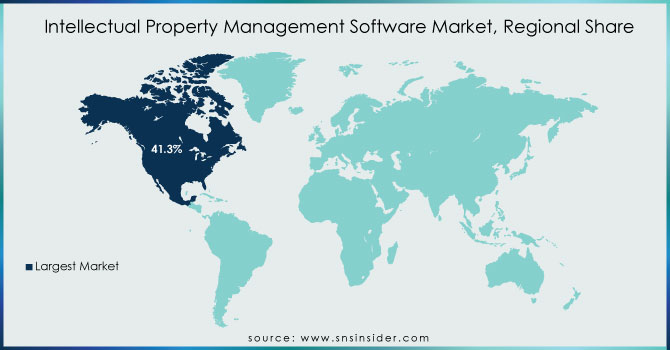Intellectual Property Management Software Market Report Scope & Overview:

To Get More Information on Intellectual Property Management Software Market - Request Sample Report
The Intellectual Property Management Software Market size was valued at USD 9.15 billion in 2023 and is expected to reach USD 29.66 billion in 2032 with a growing CAGR of 13.99% from 2024 to 2032.
The intellectual property management software market is growing significantly due to the increasing awareness about need to protect companies' intellectual property while developing and raising their investment in research and development in the market. Consequently, higher investment leads to an increased volume of IP in the market, which demands better and more sophisticated software that could solve the problem as the old one does not scale. Moreover, the business has gotten more global, and therefore the expansion of the already complicated intellectual property challenge across various jurisdictions has become more and more a must-have for businesses. In addition, as intellectual ownership becomes more and more the only way to sustain itself properly, companies will have to implement a well-documented and correctly developed system that will evolve within the company as required.
On the other hand, the government has begun to make it obligatory to follow strict regulatory compliance rules, and the requirement of risk management and lowered litigation costs will drive companies towards the software to escape any possible legal problems. Furthermore, the $140 million, that The White House has invested in AI, gives companies clear incentives to buy the software, especially with the contracts, as the IP rights of the provider will be explicitly written in the hundreds of contracts. This, in combination with AI and automation possible through it, will allow companies to make fewer mistakes in allocating patents and trademarks and in tracking the company IP. It will, in turn, allow software developers to provide more efficient software while being easier to use. The second driver is the increase in mergers and acquisitions in IT companies, which allows some big IT companies to acquire the IP of other companies. As a consequence, the IP of such companies becomes more complicated, and the software is required to integrate them smoothly into their IT portfolio. In addition, to monetizing their large IT assets, companies will look more to monetize their smaller IPs, which will require them to properly manage a system of copyright licenses, and other sources of income from the IPs. For example, on Feb 2, 2024, MaxVal Group struck a strategic partnership with the AI-driven patent analytics developer Relecura. In this partnership, Relecura will also sell its data to MaxVal, which will also have an opportunity to integrate it into MaxVal’s Symphony, the flagship IP management platform.
Market Dynamics
Drivers
-
Growing focus on managing and safeguarding intellectual property.
-
Rising adoption of intellectual property (IP) in the digital economy and the emergence of new business models.
The growing use of intellectual property in the digital economy is driven by the rapid development of technology, e-commerce, and digital platforms. As per the research, in 2023, world e-commerce sales became $5.5 trillion, and digital platforms continue to take an increasing share of the global economy. The increased use of online resources by a larger number of businesses has made it more critical to protect digital assets, such as software, trademarks, and intellectual property rights to proprietary algorithms. Therefore, with this situation, the use of intellectual property has grown, and digital patents and trademarks have gained a new dimension. More specifically, the fact that in 2023, the number of software patents registered in the world amounted to 8%. However, the growing use of intellectual property is connected not only with the increasing number of online businesses.
Another reason is the emergence of new business models, primarily those that are based on digital technologies, such as artificial intelligence, blockchain, and the Internet of Things. These technologies enable businesses to develop new products and services, and as a result, the number of intellectual property assets grows. In turn, companies should register more patents and trademarks to protect these assets and preserve their competitive advantage in the market. More specifically, the fact that between 2020 and 2022, 1,90,000 AI patents were registered. Altogether, the growing number of digital assets results in the growing complexity of managing patents and trademarks, which is facilitated with such tools as advanced IP management software.
Restrains
-
Intricate intellectual property laws and regulations vary across different countries, posing challenges for businesses.
-
The high costs and complexity associated with IP systems
Considering that IP laws and regulations can significantly differ from one country to another, this aspect can be seen as one of the main legal considerations. In the United States, IP law is regulated by a number of federal statutes such as the Copyright Act, Patent Act, and the Lanham Act. The U.S. system of IP legislation is built upon providing strong protection. On the one hand, it is an encouraging approach that supports innovative activities and ensures creators are protected; on the other hand, this strong protection entails a necessary understanding of these laws for businesses because they have to remain extra cautious and avoid any form of infringement or piracy. UK IP laws “are derived from multiple sources, including both domestic legislation and international agreements.” Some of the key statutes are the Copyright, Designs, and Patents Act 1988 and the Trade Marks Act 1994. In reality, U.K. laws are even more standardized and regulated within the context of the European Union. Thus, post-Brexit businesses should not expect less protection and a more liberal approach. What this all means is that Intellectual Property Management Software should be versatile, adapted to the specifics of various jurisdictions, and sufficiently advanced to manage cross-border IP. Businesses should also recognize this diversity and number of distinct requirements to ensure they remain compliant and their IP is protected globally to the best extent possible.
Opportunities
-
The shift towards digital business models generates new forms of IP, requiring specialized management solutions.
Market segmentation
By Type
By Type, patent intellectual property management held a significant revenue share of more than 32% in 2023. In the United Kingdom, there were 19,943 patent applications in 2023, which is an increase of about 2.4% from the previous year. However, this does not explain the 20.8% decrease in granted patents which also indicates the complexity of the task required to achieve patent protection. The increase in applications in the UK is seen as a company’s rush to the UK Intellectual Property Office to secure their ideas before they are legally patented, or many are in the examination stage, and others have not been granted. The United States has equal experience with the patent landscape being active the same. The United States has been consistent in having the highest applications for patent globally. This data helps in explaining the share of the “patent management” in the IP management software market’s revenue. The substantial share of revenue attributed to patent management in the IP software market aligns with the increasing need for businesses to protect and manage their innovations effectively in a competitive global market.
By Deployment
The on-premise segment dominated the intellectual property management software market by deployment with the highest revenue share of more than 52.3% in 2023. Companies’ need for improved control over highly valuable intellectual property data has enabled this trend. In addition to that, the pharmaceuticals, technology, and manufacturing industries are largely in need of on-premise deployment because of relatively strict industry compliance and security requirements. The extensive use of the on-premise deployment is also justified by the complex nature of IP data management, and smaller companies that have fewer features and their patents, trademarks, and innovations are still manageable by relatively simple cloud-based solutions that are no longer in existence. The relatively customizable on-premise solutions are required to gain the necessary control and full features of highly compartmentalized IP data, which has prompted the dominance of this deployment in 2023, despite the growing adoption of the cloud-based solution method.
Hence, the dominance of on-premise deployment was one of the most expected findings of the forecast, and the trend described above has been observed for a long time. Therefore, the necessity to adhere to the relevant industry regulations has been keeping the on-premise deployment in power. Furthermore, the challenges related to data breaches and an increasingly stringent level of data security measures also contribute to this trend.

Do You Need any Customization Research on Intellectual Property Management Software Market - Enquire Now
By End-Use Industry
For the end-use industry, the BFSI industry led the intellectual property management software market in 2023 with a revenue share of over 36.5%. The rapid pace of digital transformation, as well as the adoption of innovative technologies, are expected to drive this dominance. Notably, as banks and the finance industry shift to digital banking, providing a personalized experience and advanced analytics have necessitated the protection and management of their intellectual property such as proprietary algorithms as well as the fintech solution. Similarly, the sector’s increasing dependence on digital channels and AI to engage its customers through the most accurate, relevant, and valuable information requires management and protection software to ensure their intellectual property is secure. Moreover, besides the growing number of mobile applications, blockchain, and IoT deployments, the emergence of open banking in line with third-party implementations through APIs has bolstered the importance of management and protection. Perhaps most relevant is the BFSI's objective to generate customer insights by utilizing big data and AI, in addition to safeguarding its innovations against fraud and hacking. The significant investment in digital innovation and the growing complexity of managing these assets have positioned the BFSI sector as the largest market for IP management software in 2023.
Regional Analysis
In 2023, North America led the intellectual property management software market, accounting for over 41.3% of the global revenue. In particular, the region’s dominance is associated with a high level of its IP activity – in the US, 418,262 patent applications were filed. It is worth noting that the figure is slightly higher than the parameter of 418,116 applications in 2022, reflecting consistent growth over the past few years. High volumes of patenting underline the urgent demand for effective IP management solutions due to the need for the firm to protect and commercialize its innovations in such a competitive industry. In addition, the growth of patent applications, which applies to such sectors as technology or pharmaceuticals, should also be noted. These firms develop a variety of innovations, and the business processes of many North American companies are based on the effective use of these assets.
Asia Pacific is expected to grow at the highest CAGR during the forecast period from 2024-2032. This growth is driven by the region's rapidly expanding IP activity, particularly in China. In 2023, China alone registered an impressive 4.383 million trademark applications, reflecting the country's strong emphasis on innovation and technological advancement. This surge in IP filings is creating a significant demand for robust IP management solutions to protect and manage these valuable assets effectively. Also, China continues to dominate global patent filings which increase the need for sophisticated IP management software, driving the market's expansion in the Asia Pacific region. The region's focus on innovation, coupled with increasing investments in R&D and the digital economy, positions it as a key growth area for IP management solutions. This expected growth aligns with the broader trend of Asia Pacific emerging as a global leader in innovation and IP protection.

Key Players:
The prominent players in the market are Cardinal Intellectual Property, Patsnap, Gemalto NV, Innovation Asset Group, Inc., Questel, Alt Legal, Inc., IP Checkups, Inc., TM Cloud, LexisNexis, Clarivate plc, Anaqua, Inc., patrix ab, Wellspring Worldwide., and others in the final report.
Recent Developments
-
Clarivate Plc., a prominent global provider of transformative intelligence, unveiled the IP Collaboration Hub™ at the 2024 Clarivate Ignite conference in San Diego, U.S. in June 2024.
-
Questel, a world leader in intellectual property (IP) management solutions, is excited to announce its strategic partnership with the innovative Swiss-based company, ipQuants, in March 2024.
-
Clarivate Plc., a global leader in delivering trusted intelligence to individuals and organizations to drive global transformation, revealed in June 2023 that Mitsubishi Electric Corporation has selected IPfolio™ from Clarivate to streamline its intellectual property (IP) operations.
-
Wellspring, a leading provider of software solutions for R&D and Innovation Management, announced the acquisition of IP Pragmatics, one of the world's top consulting and services companies for Tech Transfer and Intellectual Property Management, in February 2023.
-
Anaqua, a premier provider of innovation and intellectual property management technology, disclosed in December 2022 that it is collaborating with innovation intelligence platform PatSnap.
| Report Attributes | Details |
| Market Size in 2023 | US$ 9.15 Billion |
| Market Size by 2032 | US$ 29.66 Billion |
| CAGR | CAGR of 13.99% From 2024 to 2032 |
| Base Year | 2023 |
| Forecast Period | 2024-2032 |
| Historical Data | 2020-2022 |
| Report Scope & Coverage | Market Size, Segments Analysis, Competitive Landscape, Regional Analysis, DROC & SWOT Analysis, Forecast Outlook |
| Key Segments | • By Type(Patent Intellectual Property Management, Trademark Intellectual Property Management, Copyright Intellectual Property Management, Design Intellectual Property Management, and Others) • By Component(Software and Service) • By Deployment(On-premises and Cloud) • By End-Use Industry (BFSI, Healthcare, Automotive, IT and Telecom, Research Institutes, and Others) |
| Regional Analysis/Coverage | North America (US, Canada, Mexico), Europe (Eastern Europe [Poland, Romania, Hungary, Turkey, Rest of Eastern Europe] Western Europe] Germany, France, UK, Italy, Spain, Netherlands, Switzerland, Austria, Rest of Western Europe]), Asia Pacific (China, India, Japan, South Korea, Vietnam, Singapore, Australia, Rest of Asia Pacific), Middle East & Africa (Middle East [UAE, Egypt, Saudi Arabia, Qatar, Rest of Middle East], Africa [Nigeria, South Africa, Rest of Africa], Latin America (Brazil, Argentina, Colombia Rest of Latin America) |
| Company Profiles | Cardinal Intellectual Property, Patsnap, Gemalto NV, Innovation Asset Group, Inc., Questel, Alt Legal, Inc., IP Checkups, Inc., TM Cloud, LexisNexis, Clarivate plc, Anaqua, Inc., patrix ab, Wellspring Worldwide. |
| Key Drivers | • The intellectual property software is projected to experience significant growth in the coming years, driven by a growing focus on managing and safeguarding intellectual property. • Rising adoption of intellectual property (IP) in the digital economy and the emergence of new business models. |
| Market Restraints | • The global intellectual property software market is expected to face challenges in its growth due to low awareness regarding IP systems. • The high costs and complexity associated with IP systems are also expected to impede the growth of the global intellectual property software market. |

